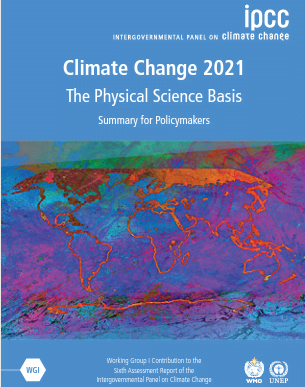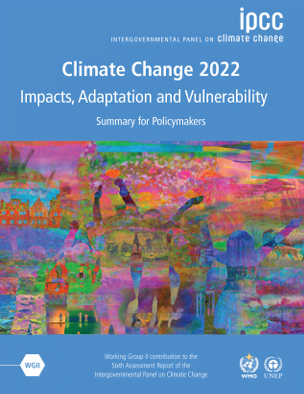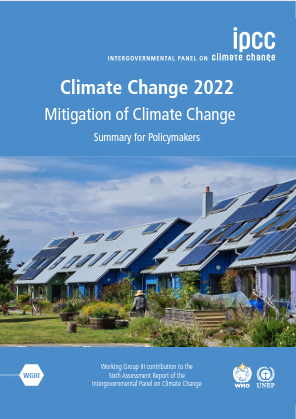The IPCC (Intergovernmental Panel on Climate Change) is the most authoritative international body on climate science. It includes governments that are members of the United Nations or WMO, currently 195 member countries. It publishes its Assessment Reports (AR) every five to eight years (the previous AR in 2014). During the cycle, scientists assess thousands of scientific papers to provide a comprehensive summary & report on the latest science of climate change.
The IPCC’s Sixth Assessment cycle produced the Sixth Assessment Report (AR6) and other important special reports from 2018 to 2023.
Three different working groups write the assessment reports (so we have three documents), focusing on specific aspects of climate change. These three reports are summarized in the Synthesis Report. During the reporting cycle, there might also be other “Special Reports” on specific issues.
Working group I. Climate Change 2021: The Physical Science Basis (released in August 2021).
The report explains the science behind climate change and the progress in understanding how the climate system works. It includes global and regional projections for future warming. It also tells us how the climate system is changing in response to human activities and the associated impacts (e.g., extreme weather events). You can find some of the most important facts in the Climate Facts section.

Following, you will find a beautiful infographic prepared by John Lang that visually explores the IPCC’s Sixth Assessment Report (WGI).

Working group II. Climate Change 2022: Impacts, Adaptation and Vulnerability (released in February 2022).
This report assessed the damages climate change is already causing (to our well-being and planet), what we can expect in the future, and what options we have to adapt to these changes. It also describes options to create a “climate resilient development*.”
*A climate resilient development is the process of implementing greenhouse gas mitigation and adaptation measures to support sustainable development.
Following, you will find a beautiful infographic prepared by John Lang that visually explores the IPCC’s Sixth Assessment Report (WGII).
Working group III. Climate Change 2022: Mitigation of Climate Change (released in April 2022).
Essentially it says that the time to take action is now if we want to keep the temperature within the Paris Agreement limits and avoid the worst effects of climate change.
The report tells us what we can do to limit and prevent human-caused GHG emissions. One of the most important messages is that we have many options available -right now! in every sector to halve the GHG emissions by 2030.

Following, you will find a beautiful infographic prepared by John Lang that visually explores the IPCC’s Sixth Assessment Report (WGIII).
The Synthesis Report draws from the findings of the three working groups above and the three Special Reports published during the current assessment cycle: Global Warming of 1.5°C, Climate Change and Land, The Ocean and Cryosphere in a Changing Climate.
Why the IPCC reports are important
The short versions of the reports, called Summaries for Policymakers (SPMs), are approved by the IPCC member governments (the 195 countries mentioned above). Approval means that the report has been subject to line-by-line discussion and agreement among the participating IPCC member countries and the scientists responsible for drafting the report.
The Synthesis Reports, instead, are adopted by the IPCC member governments, meaning that there is a section-by-section discussion among participating governments and the authors to agree on the document.
Representatives from 195 Countries approve and adopt the reports. They have all the information and knowledge (developed by the best scientists) about one of the greatest risks facing humanity – and with it, an obligation to act.
The most important messages from scientists
Scientists tell us that human activities such as burning fossil fuels, land use, land-use change, our lifestyles, and our consumption are causing significant changes to our climate system (producing GHG emissions that are warming our planet).
They also tell us that we will not stay under the 1.5C limit (compared to pre-industrial levels) of the Paris Agreement if we don’t act urgently. We need to start reducing our GHG emissions right now and halve them by 2030 (compared to 2010 levels).
We are already experiencing the devastating effects of climate change (floods, heatwaves, droughts, fires, etc.), and it will get worse if we don’t act. We also need to invest in adaptation measures to protect communities, especially the most vulnerable (within and among countries), with losses and damages already happening (e.g., small islands).
Scientists’ message is clear: we need climate action now to secure a sustainable future for all.
It is crucial to evaluate climate action in the context of sustainable development because climate change actions can result in trade-offs. The Sustainable Development Goals (SDGs) can be used as framework to identify equitable climate actions.
